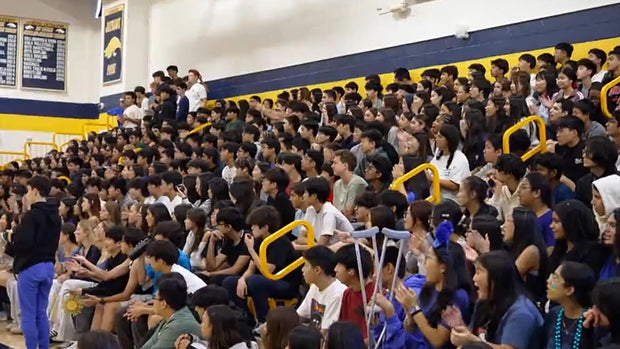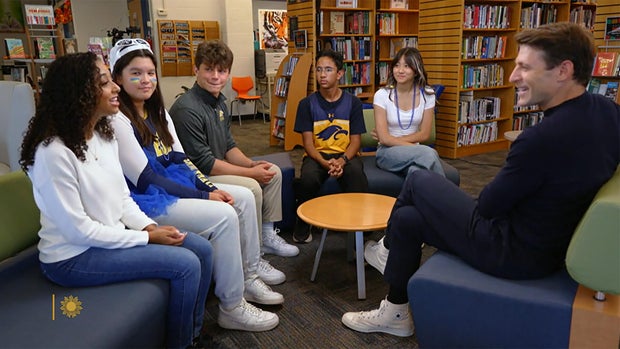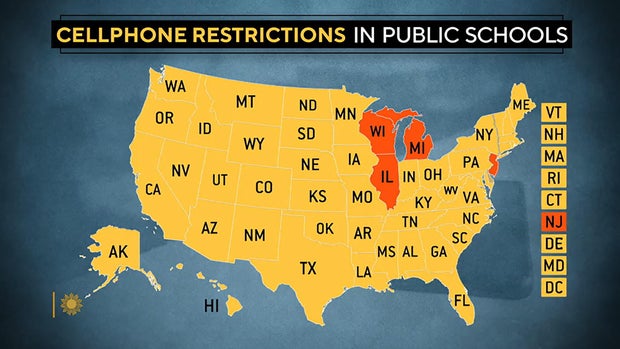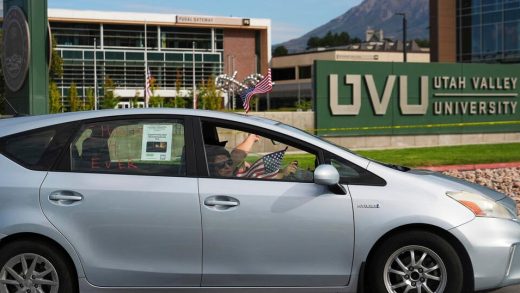Homecoming day at Jericho High School on New York’s Long Island looked very different this year. Same big display of school spirit on the gym floor, but up in the stands, there were no cell phones at this pep rally, because this year students have to put them away for the whole school day, “bell to bell.”
New York, along with most other states, has mandated cell phone restrictions in public schools. Other states are considering legislation, too – which means a whole new world for kids, nearly all of whom (from high school age on down) were born after the first iPhone hit the market.
CBS News
“We always have our phones,” said 17-year-old Sabrina Cruz. “Now it’s like, we can’t even have our phones, so like, can we even remember this moment, like, ten years from now? Sometimes I wish I had my phone.”
The fact is, smartphones carry much of their life stories.
We spoke to several Jericho High students, who were about a month into the new no-phones policy.
Senior Adam Cohen said, “I’m having, in a sense, a little separation anxiety. Just a little bit. I can’t have my mom in my pocket, can’t have my dad in my pocket, can’t have my friends in my pocket.”
CBS News
Inconvenient, perhaps, but phones, if we even have to tell you, had, in the opinion of most high school teachers, become a “major problem” in the classroom. Social media was a game-changer, said Brian Cummings, co-principal at Jericho High. “Students were relying on the cell phone for social interaction,” he said. “Students were using the cell phones in class when they should have been paying attention to their teachers.”
Now, it’s the students, too, who say they were missing something when they had their phones in class.
“I honestly realized that this year a lot of the things are pretty interesting,” said Sabrina. “For example, like, I was never a big history person. I was always, like, on my phone because I was like, This is boring. But this year I’m like, Oh wow, this is actually really interesting because it relates with my world right now.”
Rayan Hasan, a 15-year-old sophomore, said, “Without the phones now especially, like, class discussions, they’re, like, a lot more engaging.”
CBS News
At the University of Pennsylvania, the kind of school many Jericho families dream of, Dr. Ezekiel Emanuel has gone even further – banning all technology in his classroom.
Aren’t college-age students already capable of paying attention? “You would be surprised,” Emanuel said. “They’re shopping, they’re Instagramming, they’re emailing, they’re looking at the newspaper. And by the way, it’s not just phones. It happens the same – I know this happens – with computers in the room, anything that has an internet link.”
And his students agree. Asked whether the premise of a technology ban implied students are not capable of regulating their use on their own, one young man, Kunal, replied, “We’re not.”
But should the technology ban go beyond cellphones? Asked if computers should be banned from classrooms as well, Adam replied, “That’s how we fall behind as a generation.”
Senior Cynthia Qian suggested, “A similar argument that they might’ve had, like, maybe 50 years ago with calculators.”
In addition to calculators, parental protection (you might say over-protection) has become the norm. Cummings said there were calls from anxious Jericho parents: “They were worried that they’re not going to be able to be in contact with their students,” he said. “If a parent needs to reach a kid and there’s an emergency, call us. We’ll pull ’em out of class immediately.”
I asked Emanuel, “Maybe the most compelling counterpoint is the idea that we live in dangerous times, and you need to be able to reach the outside world, and the outside world needs to be able to reach you at all times, for safety reasons?”
“Let’s solve the danger problem not by using phones,” he replied. “And a parent contacting a kid doesn’t solve the danger problem, [it] just assuages the anxiety.”
As for the kids, they are still sorting out what a phone-free school day means for their social lives, like meeting up with friends, or making arrangements for lunch. “We’ve only had the phone ban for, like, four weeks. I think we still need a little bit more time,” said Cynthia.
Adam said, “My friends have, like, found this one gathering spot. So, in-between periods, if I can’t find anyone, they’re probably there.”
Sabrina said, “At least for me, I usually just see my friends in the hallways. I’ll be like, ‘Oh, are you gonna be in the lunchroom this period?'”
In other words, they talk with each other.
This kind of learning is also what makes their principal think the ban is working. “You go into the cafeteria now, it’s maybe twice as loud as it used to be – I’m not even exaggerating,” he said. “More kids are talking to each other. One of the most important things of high school is the students learning to become better versions of themselves and get well-rounded. And how can communication not be a big part of that?”
And, at the end of a phone-free day, when asked if life is better with no phones this year compared to last year, the students said yes.
Fifteen-year-old Sonia Ngai said, “I think I’m living more in the moment.”
Those moments are to be savored, they now realize, because while smartphones may go on forever, their last year of high school will not.
“A lot of sports teams, they had digital cameras and stuff like that,” said Sonia. “I took a bunch of photos with different people. It was more sentimental in a way to take it on the digital camera.”
“It’s like going back, like, years,” Sabrina said, “before we were ever born.”
“Back in the day!” said Adam.
For more info:
Story produced by Mary Raffalli. Editor: Carol Ross.




